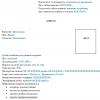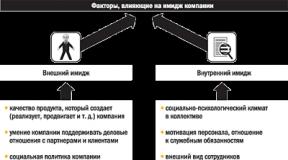Trichinosis in 1996. Trichinosis - we prevent the disease. Prevention and control measures
Many helminthic diseases are transmitted to humans from animals (more about infectious diseases transmitted from animals to humans). And, it is about one of these diseases - about trichinosis, that we want to tell you today. What is the danger, how can you get infected, and how to prevent trichinosis- about all this on the pages of our article ...
Description of trichinosis

Healthy animals, eating sick animals and their corpses, become infected with Trichinella and themselves become sources of the spread of the disease. But, here pets, as a rule, become infected with trichenellosis when they are fed the carcasses or entrails of animals caught in the hunt, or when they eat garbage and carrion.
A person becomes infected with trichinosis when eating meat of a pig, wild boar, bear, badger, which contains live Trichinella larvae.
It is enough to eat 10-15 grams of Trichinosis meat in order to get an incurable serious illness.
Trichinosis symptoms
Vivid signs of the disease can be called swelling of the eyelids, which prevents the patient from opening his eyes, puffiness of the face, severe pain in the muscles, soreness when moving the eyeballs, swelling of the tongue, as a result of which it is difficult to speak and swallow food, pain when breathing, sharp headaches, fever and insomnia ... The mortality rate for trichinosis can reach 30%.
Prevention of the spread of trichinosis

In order to prevent the spread of trichinosis among people and animals, it is recommended to adhere to the following rules:
- Each pork carcass, as well as carcass, and other animals, before being eaten, must be subject to a mandatory veterinary examination.
- Do not feed pets with Trichinosis meat.
- The carcasses of wild animals, as well as the corpses of domestic animals affected by trichinosis, must be disposed of, and in case of impossible disposal, they must be burned or buried deep in the ground.
- In places of slaughter and butchering of animals, storage of meat products or animal carcasses, it is imperative to carry out regular deratization, to exterminate mice and rats, burning the corpses of rodents or burying them deep in the ground at cattle burial grounds.
Today we talked about trichinosis, about how dangerous this disease is, how infection occurs, how to prevent the spread of trichinosis.
And what measures are you taking in order to protect yourself from trichinosis? Share with us your experiences, stories.
The article was prepared based on the materials of the helminthologist. V. Ostrovskaya, taken from free sources.
(Trichinellosis)
Symptoms and course. The incubation period for human trichinosis often lasts from 10 to 25 days. Short (5-8 days) and long (28-30 days) incubation period is rare. As a rule, prolonged incubation is observed with a mild course of trichinosis and vice versa. Already from the first days of the disease, there is a feeling of poor health, headache, fever, sometimes up to 39-400 C, swelling of the eyelids and face, blood eosinophilia. Muscle pains soon develop. A polymorphic rash, conjunctivitis, and conjunctival hemorrhages often appear. In the acute period, there are insomnia, headaches, hallucinations, and sometimes depression. In complicated cases, more persistent neurological and psychotic syndromes develop. Abdominal pain and dyspeptic disorders are observed in no more than a quarter of patients, diarrhea is rare. At the onset of the disease, some of the marked symptoms may be absent. The complete clinical picture develops within 2-4 days. Mild diseases often occur without a rise in temperature, pronounced myalgias and are difficult to diagnose. A polymorphic clinical course of trichinosis is often observed.
Remitting fever occurs in most patients. With mild diseases and moderate severity, it usually increases within 1-4 days, and in severe patients - in a longer period (13-20 days). Swelling of the eyelids and the entire face in combination with conjunctivitis is one of the permanent signs of trichinosis. Some patients develop pronounced edema - a moon-shaped face. Less commonly, there is swelling in the arms and legs. For light and medium severe course diseases of edema quickly arise and last 1-2 and, less often, 3 weeks. With complicated trichinosis, edema, like fever, develops more slowly and reaches a maximum at a later date. Muscle pains are found in the overwhelming number of patients and appear after 1-3 or more days from the onset of the disease. Muscle pains appear first lower limbs, then in other muscle groups - gluteal, back, abdomen, arms, neck, chewing, tongue, pharynx, eye. The more severe the disease progresses, the earlier they occur. In severe cases of trichinosis, severe myalgias with contractures may appear.
From laboratory indicators, attention is drawn to blood eosinophilia. There is a direct relationship between the number of eosinophils and the degree of other clinical manifestations. The clinically pronounced course of the disease is accompanied by an increase in eosinophils in the blood up to 50-60%, maximum up to 80-93% against the background of leukocytosis up to 10,000-30,000 in 1 μl. Extremely severe forms of the disease, on the contrary, occur with hypoeosinophilia, and in the terminal period with aneosinophilia. Eosinophilia up to 10-15% can persist for 2-3 months or more after recovery. The maximum figures for eosinophilia are reached with a mild course at the 4th week of the disease, with moderate and severe ones - at the 3rd week. The appearance of severe organ complications leads to a sharp decrease in the percentage of eosinophils. A biochemical blood test determines the manifestations of dysproteinemia (hypoalbuminemia and hypergammaglobulinemia against the background of general hypoproteinemia). The level of alanine transaminase is often increased, but more often it increases gradually. Pneumonia is characterized by a diffuse increase in the vascular pattern, often pleural damage.
Diagnosis and differential diagnosis. The diagnosis of trichinosis is established on the basis of the typical clinical picture, epidemiological premises and the study of meat, which could have caused the infection, for Trichinella larvae. Serological reactions become positive only at 3-4 weeks of invasion, which makes them useful mainly for retrospective diagnosis of the disease. Often, with trichinosis, powerful glucocorticoid therapy is performed, which also affects the result of serological studies. In rare cases, to confirm the diagnosis (but not earlier than the 9-10th day of illness), a biopsy is performed, which is performed by a surgeon under anesthesia from the trapezius, deltoid or gastrocnemius muscles. A biopsy can be done from any muscle that does not have large vessels. Sexually mature trichinella are not found in feces. V venous blood also, it is practically impossible to detect migratory larvae due to their short-term stay in the vascular bed.
Trichinosis, especially where it is rare, is not always recognized immediately, and it often has to be differentiated with acute intestinal infections, typhoid or typhus, influenza and acute respiratory infections, Quincke's edema, pneumonia, toxic pharyngeal diphtheria, leptospirosis, hemorrhagic fever with renal syndrome, etc. For serological verification of trichinosis, the following immunological reactions are used: complement binding reaction, ring precipitation reaction and precipitation reaction, which are carried out, as a rule, with paired sera of the patient's blood.
Trichinosis - zoonotic biohelminthiasis caused by larvae Trichinella spiralis and characterized by an acute course, fever, severe allergic manifestations and damage to the striated muscles. In severe cases, the disease is complicated by myocarditis, focal or diffuse lung damage, central nervous system, systemic vascular lesions.
The first information about human trichinosis in Belarus dates back to 1888-1892. (144 patients). In the 20-30s of the XX century, severe outbreaks with fatal outcomes were recorded. For 1888-1996 trichinosis (with partial registration of the war years) 14,283 people, of which 800 - before 1941, 6310 - in 1948-1958. and 7214 - for 1958-1996. In 2006, 37 patients with trichinosis were registered in the Republic of Belarus, in 2007 - 36.
Until the early 70s, trichinosis was a synanthropic disease associated with the consumption of domestic pig meat, especially fresh meat, and meat products prepared from it. The cause of the disease was Trichinella spiralis... Epidemiologically, the infection was characterized by large outbreaks that occurred during the slaughter of pigs (November - April) and a predominance in the structure rural population... At that time, the disease had a severe long (up to 2-3 months) course. The patients had remitting fever, muscle pain, severe edema (especially of the face), eosinophilia, less often dyspeptic syndrome, exanthema. There were complications such as myocarditis, pneumonia, thrombosis of various localization. More often the disease was registered in Minsk, Mogilev, Gomel, less often - Vitebsk regions.
Since the 70s, in connection with the development of hunting, there has been an increase in "natural" trichinosis. For 100 years Belarus has turned from a classical synanthropic focus of trichinosis into a natural focus, in which, however, occasionally separate synanthropic outbreaks occur.
Etiology
The causative agent of trichinosis - round worm Trichinella spiralis(less often the disease is caused Trichinella nativa, Trichinella pseudospiralis). Sexually mature Trichinella (females up to 2-4 mm long, males 1-2 mm) are located in the mucous membrane of the small intestine, partially hanging freely into its lumen. After fertilization of the females, the males die. Females are viviparous, are in small intestine within 3-4 weeks, with massive invasions - up to 5-6 weeks. During this time, one female gives birth to 200 to 2000 larvae about 0.1 mm in size. Larval migration begins on the sixth day after infection. The larvae through the lymph and bloodstream are carried throughout the body and settle in the striated muscles. There they increase in size up to 0.8-1 mm, begin to curl up into a spiral. By 3-4 weeks, a fibrous capsule is formed around the larvae, which is gradually impregnated with calcium salts. However, even in calcined capsules, the larvae can remain viable for many years. If meat with invasive larvae is eaten by one of the many hosts of Trichinella (human, pig, rat, etc.), Trichinella larvae are released from the capsule and then penetrate into the outer layer of the mucous membrane of the small intestine. Within two days, they ripen and fertilize.
Thus, one and the same organism of a warm-blooded animal serves for Trichinella, first as the final (definitive), and then as an intermediate host.
Epidemiology
Trichinosis is a natural focal disease. Distinguish between natural, synanthropic and mixed foci of trichinosis. In natural foci, the defeat of wild animals is noted: rats, mice and other small rodents, hedgehogs, badgers, raccoon dogs, foxes, wolves, bears (brown, white), wild boars. In synanthropic foci surrounded by humans, the circulation of the pathogen occurs mainly between pigs and rats. Mixed foci arise in the environment of a person, where the pathogen is brought in from natural foci in different ways (for example, with the unsupervised keeping of pigs).
Pathogenesis
The intensity of infection, as a rule, is associated with the degree of invasion of the animal that served as the source of the invasion, less often with the amount of meat eaten. Depending on the intensity of invasion, the process of hatching, migration and encapsulation of larvae lasts up to 3-6 weeks. After the formation of a fibrous capsule, the entry of metabolites (antigens) of the larvae into the body and the manifestations of a general allergic reaction cease.
Trichinella most often affect the most actively working muscles, which are abundantly supplied with blood saturated with oxygen: the legs of the diaphragm; intercostal, chewing, oculomotor, cervical muscles; muscles of the larynx and tongue. With intensive invasion, 1 g of these muscles can contain from 50 to 100 or more Trichinella larvae. Due to the productive inflammatory process, intense cellular infiltration forms around the larva, and then a capsule is formed, consisting of the sarcolemma of the muscle fiber, connective tissue and hyaline layers.
With moderately intense infection, hatching, migration and dispersal of larvae in the muscles occurs during the incubation period. Clinical manifestations occur only with the development of a general allergic reaction. Due to severe microcirculation disorders, general edema rapidly develops, accompanied by severe hypoproteinemia. Focal infiltrates around Trichinella larvae in the brain, myocardium, lungs, along with general vascular disorders, contribute to metabolic disorders in the parenchyma of these organs. With intensive invasion, diffuse focal myocarditis, meningoencephalitis, and focal pneumonia develop.
Pathological anatomy
Pathomorphologically, trichinosis is characterized by catarrhal inflammation and edema of the mucous membrane small intestine... Sometimes here you can find superficial necrosis, small punctate hemorrhages. In the liver, you can often find fatty infiltration, in the spleen - hyperemia, hyperplasia of the red pulp, heart attacks. In skeletal muscle tissue, waxy fatty degeneration, simple atrophy of muscle fibers and other signs of an inflammatory reaction are observed; in the myocardium - loss of transverse striation, turbid swelling, fiber fragmentation, inflammatory infiltrates; in the lungs - hemorrhages and sometimes signs of pneumonia.
In the central nervous system, manifestations of meningoencephalitis and cerebral thrombosis can be observed.
Clinical picture
The incubation period for trichinosis ranges from 5 to 30 days, usually 10-25 days. With a severe course of the disease, it can be shortened, and with a mild course, it can be lengthened.
The main diagnostic criteria for trichinosis are fever, edema, muscle pain and eosinophilia.
Sometimes the disease can begin with precursors, when for 2-3, and sometimes 15-20 days, patients complain of weakness, a feeling of fatigue, headache, gastrointestinal disorders.
More often, the disease begins acutely with a rise in body temperature to 38-39 ° C. It should be noted that body temperature can reach high numbers both suddenly and after several days of subfebrile. Fever is persistent or laxative.
As a rule, fever occurs 3 days after the onset of edema, although it may appear simultaneously with them or 1-2 days before them. Swelling of the face and especially the eyelids is a pathognomonic sign of trichinosis, therefore, the people call the disease "puffy". Swelling of the eyelids is sometimes so pronounced that the patient cannot open his eyes. Puffiness of the whole face, conjunctivitis gradually develops. In some patients, edema can spread to the arms, legs, sacrum, scrotum. Swelling lasts 5-8 days, and sometimes 2-4 weeks.
Although cases of trichinosis without muscle pain are described in the literature, this symptom is one of the characteristic features of the disease. Muscle pain accompanied by muscle weakness occurs 1–3 days after the onset of edema, usually accompanied by fever. Patients complain of pain in the muscles of the legs, thighs, tongue, eyeballs; in the chewing, gastrocnemius, intercostal and cervical muscles. The pain increases with movement. On examination and palpation, the muscles reveal their swelling and induration. Often contractures of the knee and elbow joints, trismus of the chewing muscles. Muscle pain usually disappears 1-2 days before the body temperature drops.
Eosinophilia is one of the most important signs of trichinosis, which appears from the first days of the disease. Combined with moderate leukocytosis, it reaches its maximum value (20-45%) at 3-4 weeks. Eosinophilia begins to decrease in 2-3 months and completely disappears only after 6 months. It should be emphasized that in severe cases of the disease, eosinophilia can sometimes be absent and appears only during the recovery period.
About 20% of patients have exanthema. Skin rashes can be very diverse: roseolous, petechial, erythematous, kore- and scarlet-like. The rash lasts from several hours to several days. Hemorrhages under the nails are often observed.
Half of the patients have gastrointestinal disorders. Usually it is nausea, vomiting, diarrhea. There may be bouts of severe abdominal pain. On palpation, the abdomen is somewhat tense and painful. The tongue is usually edematous and covered with a white coating. Hepatosplenomegaly is rare.
From the side of cardio-vascular system note pain in the region of the heart, tachycardia. Heart sounds are often muffled. Blood pressure tends to decrease. On the electrocardiogram (ECG), a decrease in the voltage of the QRS complex, a flattened or negative T wave is recorded. In a severe course of the disease, progressive cardiovascular failure develops.
Appears early in patients and persists for a long time headache... Insomnia is often observed, and in some patients, on the contrary, drowsiness. Impairment of consciousness is rare. There may be paresthesias of the skin, weakening or even disappearance of tendon and abdominal reflexes.
On the part of the organ of vision, in addition to the previously described conjunctivitis, there may be paresis and paralysis of the external muscles of the eye, hemorrhages in the conjunctiva, exophthalmos arising from edema of the orbital tissue.
It should be emphasized that, in addition to typical cases of trichinosis, occurring in the presence of four main symptoms (facial edema, fever, muscle pain, eosinophilia in the blood), an atypical course of the disease is described in the literature, in which some of these manifestations are absent or weak. The beginning of the disease with meningitis, encephalitis, hemiplegia is described. Subclinical and erased forms are common. The total duration of the disease varies from one to 5-8 weeks or more.
Allocate erased, mild, moderate and severe trichinosis. With an erased course of the disease, the incubation period is difficult to determine. In general, the disease lasts no more than a week and is accompanied by subfebrile body temperature, mild myalgia, swelling of the face, moderate eosinophilia (7-10%) with a normal number of leukocytes.
At mild form trichinosis, the incubation period is 25-35 days. This form is characterized by high fever that persists for a week. Swelling and myalgia are quite pronounced. Eosinophilia reaches 10-20%.
With a moderate course, the incubation period is shortened to 15-20 days. The disease begins with intermittent fever. Body temperature quickly reaches 38-40 ° C, followed by a gradual decrease within 2 weeks to subfebrile values. During this period, muscle and edematous syndromes are most pronounced. Conjunctivitis may develop. During a fever, there may be abdominal pain, increased stool up to 2-3 times a day, nausea, vomiting. Hives-like rashes can be observed on the skin. Pulmonary syndrome develops as a catarrh of the upper respiratory tract, sometimes with volatile eosinophilic infiltrates in the lungs with pleural involvement. On the part of the cardiovascular system, there is a decrease blood pressure, heart tones are muffled. The ECG shows moderate dystrophic changes. Children often have pain when swallowing, enlargement of the tonsils, more often cervical, but other groups may also be involved lymph nodes... Splenomegaly is possible. An eosinophilic-leukemoid reaction may develop.
The severe course of the disease is distinguished by the atypical nature of the clinic and the presence of organ lesions. The incubation period is significantly shortened and, as a rule, does not exceed 1 week. The body temperature rises gradually over 2-4 weeks, reaching 39-40 ° C. Against this background, pain and muscle swelling increase. Loose swelling connective tissue leads to cheliosis, diplopia, exophthalmos; increasing edema of the membranes and parenchyma of the brain - to agitation, insomnia, hallucinations. Characteristic is the presence of an erythematous-papular, hemorrhagic rash on the trunk, the inner surface of the extremities. From the first days of the disease, an abdominal syndrome develops with diffuse abdominal pain. Nausea, vomiting, diarrhea (stools with mucus, blood) are observed. Benign allergic hepatitis may develop. The severe course of trichinosis can be complicated by necrotic ulcerative lesions of the stomach and small intestine, myocarditis, pneumonia, pulmonary heart disease, which can be the cause of death.
Immunity
Diagnostics
Diagnosis of trichinosis is based on the clinical picture (acute onset of the disease with a sudden rise in temperature, facial edema, myalgia, leukocytosis, eosinophilia, and in severe forms - damage to the heart, lungs, central nervous system), epidemiological history data (eating pork, wild meat animals, and above all wild boar). An important indirect confirmation of the diagnosis is the detection of Trichinella larvae in the preserved meat by means of compressor trichinelloscopy or artificial digestion.
The method of immunoassay with Trichinosis antigen is widely used in laboratory practice. Investigate paired sera taken at intervals of 2-3 weeks. Specific antibodies appear 14-15 days after infection. Their level reaches the maximum value at 4-12 weeks. In those who have had trichinosis, antibodies sometimes persist for up to 2 years.
In exceptional cases, to confirm the diagnosis, no earlier than the 9-10th day of the disease, a biopsy of muscle tissue (deltoid, gastrocnemius muscles) is performed to detect Trichinella larvae.
For the retrospective diagnosis of trichinosis (from the third year after the onset of the disease), an X-ray method is used. On roentgenograms, the calcified encapsulated Trichinella larvae are detected in the form of small light formations.
Treatment
Treatment of patients with trichinosis is carried out in a hospital. In the acute period of the disease, bed rest is required. Etiotropic therapy is indicated for all patients with trichinosis, it is most effective in the first two weeks after infection, until the female helminths begin to hatch larvae, and after encapsulation, Trichinella is significantly reduced. Albendazole is the drug of choice. Mebendazole can be used.
Symptomatic therapy includes the appointment of antihistamines, non-steroidal anti-inflammatory drugs, etc. In case of severe invasion with neurological disorders, myocarditis, pulmonary insufficiency, glucocorticosteroids are used: daily dose 20-80 mg for 5-7 days, followed by dose reduction and drug withdrawal after 1-1.5 weeks. Due to the fact that glucocorticosteroids can lengthen both the production period and the number of larvae in the intestine, it is recommended to use anthelmintic drugs during the entire period of glucocorticosteroid use and several days after their cancellation.
Dispensary observation
The observation of those who have recovered from trichinosis is carried out by an infectious disease doctor for 6 months. Reconvalescents are recommended to be examined 2 weeks, 1-2 and 5-6 months after discharge from the hospital with mandatory examination general analysis blood and ECG.
Modern aspects of trichinosis
During 2006-2007. in the Minsk city infectious disease clinical hospital 18 people were on treatment for trichinosis, of which only one case was sporadic, the rest from group outbreaks (3 people in 2006 and 14 people from one outbreak in 2007). Among the observed were 12 men and 6 women. The age of the sick is from 23 to 59 years. Attention is drawn to the fact that only 4 (22%) people were sent to the hospital with a diagnosis of trichinosis. These were patients from the focus of infection. 11 people (61%) were hospitalized for acute respiratory viral infection and 3 (27%) people with influenza.
In all patients, the diagnosis was confirmed epidemiologically, clinically and serologically (by enzyme-linked immunosorbent assay).
Patients were admitted to the hospital at different times from the onset of the disease. On the second day, 2 people were admitted, on the third - 2, on the fourth - 4, on the fifth - 4, on the sixth - 3, on the seventh - 1, on the eighth - 1, on the ninth - 2, on the fourteenth - 1.
One patient had a history of eating pork kebabs, while the rest clearly indicated the fact of eating wild boar meat.
The disease had a mild (15 people) or moderate (3 people) course. Severe cases of the disease and complications were not observed.
With a mild course of the disease, the incubation period ranged from 17 to 35 days, with a moderate course - 17-18.
On admission, all patients had fever. 14 (78%) people complained of muscle pain, 12 (67%) complained of edema, 9 (50%) complained of weakness, 5 (28%) complained of headache, 2 (11%) patients complained of pain in the region of the heart, conjunctivitis - 1 (6%). Rash occurred in 7 (39%) people, gastrointestinal disorders - in 2 (11%).
Fever in 12 patients reached febrile numbers, in 6 - subfebrile. With a mild course of infection, the body temperature remained for 2-6 days, with a moderate course - up to 7-9.
Muscle pains were noted in typical places: in the calf, femoral, temporal, occipital muscles, when swallowing, in the muscles eyeball... All patients had eyelid and facial edema.
A maculopapular rash was observed in 7 people (6 - mild course of the disease, 1 - moderate). The rash was localized on the chest, limbs, abdominal skin.
Gastrointestinal disorders were manifested by nausea, frequent loose stools, pain syndrome(cutting pains before stool).
On admission to the hospital, 17 (95%) of 18 patients had eosinophilia from 8 to 36%, leukocytosis from 10 x 10 9 / l to 15.7 x 10 9 / l - in 16 people (89%). V biochemical analysis blood levels in 4 (22%) patients showed an increase in the level of bilirubin up to 37.5 μmol / l.
Changes in laboratory parameters depending on the severity of the course of the disease are presented in table. one.
The ECG in 8 patients during the course of the disease recorded sinus tachycardia, in 3 people - dystrophic changes, in 1 - conduction disturbance.
The average length of hospital stay was 15 days.
The patients received mebendazole as an etiotropic drug. Against the background of treatment with mebendazole, an increase in body temperature was noted in all patients in the first two days of admission.
No complications were observed in the course of the disease. All patients were discharged home with normalization of clinical and laboratory parameters.
Thus, at present, trichinosis is more often mild and has a typical clinical and laboratory picture. The main source of infection is wild animals, primarily wild boars. However, despite the typical clinical picture, the disease is not always diagnosed in the early period.
Trichinella are small nematodes with a cylindrical, colorless body covered with a transparent cuticle of a ring-like structure. The length of an unfertilized female is 1.5–1.8 mm, a fertilized one is up to 4.4 mm, a sexually mature male is about 1.2–2 mm, the diameter of helminths is less than 0.5 mm. Unlike other nematodes, Trichinella is viviparous helminths. Their larvae, juvenile Trichinella, are rod-shaped, up to 0.1 mm long; after 18–20 days of development, the larva elongates to 0.7–1.0 mm.
Trichinella larvae found in the muscles of animals are resistant to high and low temperatures. Heating meat containing encapsulated Trichinella larvae in a microwave oven to 81 ° C does not ensure their inactivation. When boiling a piece of meat about 10 cm thick, the larvae die only after 2–2.5 hours. The larvae are resistant to such types of culinary processing as salting, smoking, freezing. The greatest danger is posed by non-thermally processed meat products: sliced meat, bacon (lard), etc.
Epidemiology of Trichinosis
The source of the causative agent for humans is domestic and wild animals affected by Trichinella. The mechanism of infection is oral. A person becomes infected by eating meat infested with Trichinella: more often pork, less often the meat of wild animals (bear, wild boar, badger, walrus, etc.).
Trichinosis is a natural focal biohelminthiasis. In many cases, it is not possible to draw clear boundaries between natural and synanthropic foci, since an exchange of the pathogen between wild and domestic animals is possible. More than 100 mammalian species are known to be hosts for Trichinella spp. The pathogen circulates between predatory (brown and polar bears, canines, felines, mustelids), facultative carnivorous artiodactyls (wild boar, reindeer, elk) and rodents (rats, voles, lemmings, etc.). Infestation of pinnipeds (walrus, seal) and cetaceans (beluga whale) is also possible. The circulation of Trichinella in nature is carried out mainly through predation and eating carrion. Encapsulated Trichinella larvae show viability and infectiousness within 4 months after complete decomposition of the corpse
an invaded animal. Synanthropic foci are secondary. The circulation of the pathogen in them usually follows the “domestic pig-rat-domestic pig” chain. A person does not participate in the circulation of Trichinella, since in the cycle of development of the helminth it becomes a biological dead end. The incidence of trichinosis is often of a group nature.
The area of distribution of trichinosis among people corresponds to that among animals. In nature, among mammals, trichinosis is recorded everywhere, with the exception of Australia. Human morbidity varies significantly across regions of the world. In Russia, synanthropic trichinosis is widespread in the temperate northern, temperate and southern zones, in the south of the Far East, Kamchatka. The main areas of trichinosis, where the infection is associated with the consumption of meat from wild animals, are the Magadan, Kamchatka regions, Krasnoyarsk Territory, the Republic of Sakha and the Khabarovsk Territory. Foci of a mixed type with the circulation of the pathogen between synanthropic (pig, cat, dog) and wild (boar, bear, rodents) animals are found in the North Caucasus.
Pathogenesis of trichinosis
The pathogenesis of trichinosis is based on the body sensitization to helminth antigens, manifested to varying degrees in the intestinal, migration
noah and muscle stages of invasion. By the end of the first week after infection, females of Trichinella are found mainly in the small intestine, immersed in the mucous membrane, around which a local catarrhal-hemorrhagic inflammatory reaction develops. With severe invasion, ulcerative-necrotic damage to the intestinal mucosa is observed.
Adult helminths secrete immunosuppressive substances that suppress the violent inflammatory response, which contributes to the migration of larvae. In the jejunum, the system of kinins, other hormones that cause functional disorders, and pain are activated. The metabolites of migrating larvae, the products released after their death, are antigens with sensitizing, enzymatic and toxic properties. As a result, pronounced allergic reactions with defeat blood vessels, coagulation disorders, tissue edema, increased secretory activity of the mucous membranes. In the second week, larvae are found not only in skeletal muscles, but also in the myocardium, lungs, kidneys, and brain. In the parenchymal organs, the larvae die.
Developing immunopathological reactions lead to severe lesions: myocarditis, meningoencephalitis, pneumonia. Inflammatory processes they subside over time, but after 5–6 weeks they can be replaced by dystrophic ones, the consequences of which disappear only after 6–12 months. Of the skeletal muscles, groups with abundant blood supply are most often affected (intercostal, chewing, oculomotor muscles, diaphragm, muscles of the neck, tongue, upper and lower extremities). In patients with a severe form of the disease, 50-100 or more Trichinella larvae are found in 1 g of muscle mass. By the end of the third week, the larvae acquire a spiral shape, intense cellular infiltration is observed around them, in the place of which a fibrous capsule then forms. The process of capsule formation is disrupted with excessive antigenic load (with massive invasion), as well as under the influence of substances with immunosuppressive properties (glucocorticoids, etc.). In __ parenchymal organs there are nodular infiltrates. In the myocardium, Trichinella larvae cause the appearance of multiple inflammatory foci in the interstitial tissue, but true capsules are not formed in the heart muscle. With intensive invasion in the myocardium,
focal diffuse inflammatory reaction and dystrophic changes; the formation of granulomas and the development of vasculitis with damage to the arterioles and capillaries of the brain and meninges are possible.
Trichinosis is characterized by persistent non-sterile immunity, which is due to the presence of encapsulated larvae of the pathogen in the muscles of infected people. The high content of specific antibodies in blood serum is noted from the end of the second week and reaches a maximum at 4-7 weeks. A complex of reactions in the enteric stage prevents a significant part of the larvae from entering the bloodstream, which limits their distribution in the body.
The clinical picture of trichinosis
The incubation period for trichinosis lasts on average 10–25 days, but can range from 5–8 days to 6 weeks. When infected in synanthropic foci (after eating infected meat of domestic pigs), an inverse relationship is observed between the duration of the incubation period and the severity of the disease: the shorter the incubation period, the more severe the clinical course, and vice versa. When infected in natural foci, such a pattern is usually not noted.
Depending on the nature clinical course the following forms of trichinosis are distinguished: asymptomatic, abortive, mild, moderate and severe.
The first symptoms in the form of nausea, vomiting, loose stools, abdominal pain in some patients appear in the coming days after eating contaminated meat and can last from several days to 6 weeks.
In the asymptomatic form, the only manifestation may be blood eosinophilia. The abortive form is characterized by short-term (lasting 1-2 days) clinical manifestations.
The main symptoms of trichinosis are fever, muscle pain, myasthenia gravis, edema, blood hypereosinophilia.
Fever of the remitting, persistent, or irregular type. Depending on the degree of invasion elevated temperature the body in patients lasts from several days to 2 weeks or longer. In some patients, low-grade fever persists for several months.
Edema syndrome appears and grows rather quickly - within 1–5 days. In mild and moderate forms of the disease, edema persists
1-2 (less often up to 3) weeks, in severe cases, the edema syndrome develops more slowly, but lasts longer and may recur. First, as a rule, periorbital edema appears, accompanied by conjunctivitis and then spreading to the face. In severe cases, edema spreads to the neck, trunk, limbs (an unfavorable prognostic sign). In patients with trichinosis, maculopapular skin rashes are observed, sometimes acquiring a hemorrhagic character, subconjunctival and subungual hemorrhages.
Muscle syndrome is manifested by myalgia, which, in severe cases, takes on a generalized character, accompanied by myasthenia gravis. Pains appear first in the muscles of the extremities, then in other muscle groups, including the chewing, tongue and pharynx, intercostal, oculomotor. In the late stage of trichinosis, muscle contractures may develop, leading to immobilization of the patient.
Diagnosis of trichinosis
During outbreaks and group diseases, in the presence of typical symptoms in patients, the diagnosis of trichinosis does not cause difficulties.
It is necessary to establish a common source of infection and, if possible, conduct a study of food debris (meat or meat products) for the presence of Trichinella larvae. Difficulties arise in diagnosing sporadic cases. In situations like this great importance has an epidemiological history.
Serological diagnostic methods can be used only in the 3rd week of illness, since in the first 2 weeks local immunity reactions prevail (intestinal phase of invasion), and the concentration of specific antibodies in the blood is low.
Antigen ELISA is used T. spiralis and RNGA. The timing of the appearance of diagnostic antibody titers depends on the intensity of the invasion and the type of pathogen: in patients with trichinosis who became infected by eating pig meat heavily infested with trichinella, antibodies are detected 15–20 days after infection; if the intensity of invasion is less, the timing of antibody detection is lengthened. When infected with meat of wild animals ( T. s. nativa) the initial period for detecting antibodies can be up to 1.5 months. The titers of specific antibodies can increase within 2–4 months after infection, noticeably decreasing after 4–5 months, however, they can remain at the diagnostic level for up to 1.5 years, and with intensive infection - up to 2–5 years.
B75. Trichinosis, a mild course of the disease. RNGA 1: 320.
Trichinosis treatment
Indications for hospitalization
Treatment of patients with moderate and severe form of trichinosis is carried out in an infectious hospital or a general therapeutic facility. Treatment is largely individual and includes specific (etiotropic) and pathogenetic therapy.
Drug therapy
suppression of larval production, disruption of the encapsulation process and increased mortality
muscle trichinella. For these purposes, albendazole and mebendazole are used.
Albendazole is prescribed orally after meals, 400 mg twice a day, to patients with
body weight 60 kg or more or 15 mg / kg per day in two doses for patients weighing
body less than 60 kg. Duration of treatment is 14 days.
Mebendazole is prescribed orally 20-30 minutes after a meal at a dose of 10 mg / kg
a day in 3 doses. The duration of the course of treatment is 14 days.
With a mild course of the disease, the same drugs are prescribed for a long-term
food invasive meat products are carried out with albendazole in the same doses
within 5-7 days. The most effective etiotropic therapy in incubation
the period when clinical manifestations can be prevented, or in the first days
diseases when Trichinella is still in the intestines. During muscle gain
for diseases and encapsulation, the effectiveness of etiotropic therapy is significant
but lower, and its use during this period may even contribute to an exacerbation
Patients are prescribed antihistamines, prostaglandic inhibitors
new, NSAIDs. For severe invasion with neurological disorders, myocar-
dit, ITS, pulmonary insufficiency, glucocorticoids are used: usually
prednisolone in a daily dose of 20-60 (according to indications up to 80) mg orally during
5-7 days. Due to the fact that glucocorticoids can lengthen the period and quantity
drugs (albendazole or mebendazole) during the entire period of use
glucocorticoids and several days after their withdrawal. The danger is
also possible ulcerative lesions of the intestine in combination with disorders in
system of hemostasis. In such patients, the risk of ulcerogenic action increases sharply.
effects of glucocorticoids, especially with the simultaneous administration of NSAIDs (indo-
metacin, diclofenac, etc.). In these cases, for the prevention of ulcerative lesions,
and etc.). Patients with severe trichinosis with generalized edema
(due to accelerated protein catabolism and hypoproteinemia) recommend
infusion therapy with the introduction of detoxifying agents and drugs
for parenteral protein nutrition.
Trichinosis- acute invasive (nematodosis) disease of mammals, accompanied by fever and severe allergic manifestations.
Epidemiology. The hosts of Trichinella are mainly carnivorous mammals, but they can also be pinnipeds, rodents, some insectivores, domestic and wild pigs. The invasion was registered in 56 mammalian species. The existence of two types of foci of trichinosis has been established: natural and synanthropic. Natural foci are primary in origin. Among domestic animals and synanthropic rodents, synanthropic foci of invasion arise and are maintained. The drift of Trichinella from natural foci leads to the formation of temporary synanthropic. Natural foci are found at all latitudes of the globe and on all continents except Australia, and outbreaks of trichinosis in humans from the consumption of meat from wild mammals are recorded everywhere. In synanthropic foci, the spread of invasion in rats and pigs is closely related: pigs willingly eat the corpses of rodents, and the latter are infected from Trichinosis pork meat. The incidence in Russia is recorded almost everywhere, human infection prevails in synanthropic foci due to the consumption of uncooked slaughter pork (in more than 95% of cases). From the meat of wild animals (wild boar, bear, badger) no more than 3% are infected. Trichinosis occurs mainly in outbreaks, sometimes affecting a large number of people. Familial outbreaks are more common. In Russia, the territory, unfavorable for trichinosis, is the Krasnodar Territory. In the neighboring countries, stationary synanthropic foci have been registered in Belarus, Lithuania, Moldova, right-bank regions of Ukraine, and the Ural region of Kazakhstan.
Symptoms and course. The incubation period for human trichinosis often lasts from 10 to 25 days. Short (5-8 days) and long (28-30 days) incubation periods are rare. As a rule, prolonged incubation is observed with a mild course of trichinosis and vice versa. Already from the first days of the disease, there is poor health, headache, fever, sometimes up to 39-40 0 C , swelling of the eyelids and face, blood eosinophilia. Muscle pains soon develop. A polymorphic rash, conjunctivitis, and conjunctival hemorrhages often appear. In the acute period, there are insomnia, headaches, hallucinations, and sometimes depression. In complicated cases, more persistent neurological and psychotic syndromes develop. Abdominal pain and dyspeptic disorders are observed in no more than a quarter of patients, diarrhea is rare. At the onset of the disease, some of the marked symptoms may be absent. The complete clinical picture develops within 2-4 days. Mild diseases often occur without a rise in temperature, pronounced myalgias and are difficult to diagnose. A polymorphic clinical course of trichinosis is often observed.
Remitting fever occurs in most patients. With mild diseases and moderate severity, it usually increases within 1-4 days, and in severe patients - in a longer period (13-20 days). Swelling of the eyelids and the entire face in combination with conjunctivitis is one of the permanent signs of trichinosis. Some patients develop pronounced edema - a moon-shaped face. Less commonly, there is swelling in the arms and legs. With a mild to moderate course of the disease, edema quickly occurs and lasts 1-2 and, less often, 3 weeks. With complicated trichinosis, edema, like fever, develops more slowly and reaches a maximum at a later date. Muscle pains are found in the overwhelming number of patients and appear after 1-3 or more days from the onset of the disease. First, pain appears in the muscles of the lower extremities, then in other muscle groups - gluteal, back, abdomen, arms, neck, chewing, tongue, pharynx, eye. The more severe the disease progresses, the earlier they occur. In severe cases of trichinosis, severe myalgias with contractures may appear.
From laboratory indicators, attention is drawn to blood eosinophilia. There is a direct relationship between the number of eosinophils and the degree of other clinical manifestations. The clinically pronounced course of the disease is accompanied by an increase in eosinophils in the blood up to 50-60%, maximum up to 80-93% against the background of leukocytosis up to 10,000-30,000 in 1 μl. Extremely severe forms of the disease, on the contrary, occur with hypoeosinophilia, and in the terminal period with aneosinophilia. Eosinophilia up to 10-15% can persist for 2-3 months or more after recovery. The maximum figures for eosinophilia are reached with a mild course at the 4th week of the disease, with moderate and severe ones - at the 3rd week. The appearance of severe organ complications leads to a sharp decrease in the percentage of eosinophils. A biochemical blood test determines the manifestations of dysproteinemia (hypoalbuminemia and hypergammaglobulinemia against the background of general hypoproteinemia). The level of alanine transaminase is often increased.
Clinical manifestations reach their maximum by the end of the first week of the disease and persist for 1-3 weeks. Muscle pain and swelling may recur periodically. Sometimes relapses occur with a rise in temperature.
Complications. With intensive invasion, trichinosis can be complicated by organ and systemic lesions. More often myocarditis and pneumonia develop, less often meningoencephalitis, abdominal syndrome, as well as damage to the liver, kidneys, phlebitis, thrombosis of large vessels. Complications develop at 3-4, less often 5 weeks of the disease. With trichinosis myocarditis, acute cardiovascular failure may occur, but more often it grows gradually. Pneumonia is characterized by a diffuse increase in the vascular pattern, often pleural damage.
Diagnosis and differential diagnosis. The diagnosis of trichinosis is established on the basis of the typical clinical picture, epidemiological premises and the study of meat, which could have caused the infection, for Trichinella larvae. Serological reactions become positive only at 3-4 weeks of invasion, which makes them useful mainly for retrospective diagnosis of the disease. Often, with trichinosis, powerful glucocorticoid therapy is performed, which also affects the result of serological studies. In rare cases, to confirm the diagnosis (but not earlier than the 9-10th day of illness), a biopsy is performed, which is performed by a surgeon under anesthesia from the trapezius, deltoid or gastrocnemius muscles. A biopsy can be done from any muscle that does not have large vessels. Sexually mature trichinella are not found in feces. It is also practically impossible to detect migratory larvae in venous blood due to their short-term stay in the vascular bed.
Trichinosis, especially where it is rare, is not always immediately recognized, and it often has to be differentiated from acute intestinal infections, typhoid or typhus, influenza and acute respiratory infections, Quincke's edema, pneumonia, toxic pharyngeal diphtheria, leptospirosis, hemorrhagic fever with renal syndrome, etc. For serological verification of trichinosis, the following immunological reactions are used: complement binding reaction, ring precipitation reaction and precipitation reaction, which are carried out, as a rule, with paired sera of the patient's blood.
Pathogenesis
The pathogenesis of trichinosis is complex, representing a complex of pathological reactions, the trigger of which is the pathogen.
The allergic nature of trichinosis underlies its pathogenesis. NN Ozeretskovskaya distinguishes three phases of the development of the pathological process: enzymatic-toxic (1-2 weeks after infection), allergic (from the end of the 2nd -3-4 weeks after infection) and immunopathological.
Enzymatic toxic phase associated with the penetration of invasive Trichinella larvae into the intestinal mucosa and the formation of adult helminths, under the influence of enzymes and metabolites of which an inflammatory reaction develops in the intestine.
However, by the end of the second - in the third week of the disease, the level of specific antibodies in the infected person's serum increases and a violent allergic reaction develops.
The immunopathological phase of trichinosis, usually associated with intense infection, is characterized by the appearance of allergic systemic vasculitis and severe organ damage.
Nodular infiltrates appear in the myocardium, brain, lungs, liver and other organs. Trichinosis is complicated by severe allergic diffuse focal myocarditis, meningoencephalitis, focal pneumonia and other equally severe organ lesions that can be combined with each other, accompanied by high fever, severe muscle pain, skin rashes, and the spread of edema.
By 5-6 weeks after infection, the inflammatory process in the parenchymal organs is replaced by dystrophic disorders, which recover slowly, over 6-12 months.
Differential diagnosis
More than 40% of cases of trichinosis fall under the primary diagnosis: influenza, ARVI or ARI.
Similar signs: acute onset of the disease, often with chills, high fever, muscle pain, back pain, headache, pain when moving the eyeballs.
Differences: with influenza and acute respiratory diseases, severe headache is usually localized in the region of the eyebrows, symptoms of upper respiratory tract damage are more pronounced (runny nose, cough, throat hyperemia, nasal congestion, weakness, malaise). With these infections, muscle pain is less pronounced, there is no edema syndrome and hypereosinophilia.
When differentiating trichinosis from typhoid and paratyphoid fever, it should be borne in mind that these infections are characterized by a more gradual development of the disease, lethargy of patients, anorexia, "typhoid tongue" - thickened and with dental prints, overlaid with a thick white or gray-dirty plaque in the middle and free from plaque with the edges and tip of the tongue, the presence of a roseolous rash in the chest and abdomen; the diagnosis is confirmed by the statement of the Vidal reaction, RNGA, the isolation of the pathogen from the blood, feces, urine.
With insufficient careful and complete clinical laboratory examination, neglect of epidemiological data, the onset of trichinosis can be regarded as food poisoning or dysentery, and in children - measles, rubella scarlet fever, tonsillitis, tonsillitis, etc.
It is also impossible not to take into account the need to differentiate trichinosis from the acute phase of other helminthiasis. In Ukraine, this primarily concerns such an invasion as opisthorchiasis, which in the acute phase can occur with similar symptoms. Differential and diagnostic signs of acute opisthorchiasis are less pronounced muscle pain, edema syndrome, ocular pathology, but more pronounced abdominal syndrome and signs of diffuse liver damage: jaundice, hepatosplenomegaly, indicators of functional tests - an increase in the level of bilirubin, enzyme activity. Critical is epidemiological anamnesis.
Epidemiological indicators such as the group nature of the disease, when several companions fall ill after holiday celebrations, after eating pork or wild animal meat, taking into account clinical indicators, are very significant for substantiating the diagnosis.
in meat that could have caused the infection;
in a biopsy specimen of the patient's muscles:
muscle tissue (5-10 g), minced in a meat grinder, is placed in an Erlenmeyer flask containing artificial gastric juice in a ratio of 1: 20 - 1: 25 and kept in a thermostat for 3.5-4 hours. Then the contents of the flask, after shaking, are poured into 50 ml test tubes and left to stand for 30 minutes, after which the supernatant layer is carefully discarded, and the precipitate is applied to glass slides and examined under a low microscope magnification.
You can use the method of digestion of biopsied material in gastric juice with the study of the sediment after centrifugation.
It has been empirically established that the number of larvae up to 200 per 1 g of muscle tissue corresponds to a moderate intensity of invasion, up to 500 - intensive, over 500 - super-intense;
in some cases, to confirm the diagnosis on the 9-11th day of the disease, a biopsy is made from the trapezius, deltoid or calf muscles of the patient. Under local anesthesia, in compliance with the rules of asepsis and antiseptics, a piece of muscle 0.5-1 x 2-3 cm in size is cut out, from which thin sections are prepared between the glasses of the compressor for microscopy. Trichinelloscopy is also used for postmortem diagnosis.
Immunological methods include:
allergic
serological methods:
allergological diagnostic techniques, with the exception of taking into account eosinophilia and intradermal test, have not been developed and are not used in healthcare practice. The disadvantages of the intradermal test are its weak sensitivity and the possibility of additional sensitization of the patient's body with the introduction of a trichinosis allergen.
Therefore, the methods of choice for the diagnosis of trichinosis are currently serological reactions with trichinosis diagnostics;
in practice, a number of serological reactions are used: RSK (complement binding reaction), RCP (ring precipitation), RNGA (indirect hemagglutination), ELISA (enzyme-linked immunosorbent assay), XRF (fluorescent antibodies).
RNGA and ELISA are the most effective diagnostic methods, ensuring the detection of 80-91% of those infested with a specificity of 92-97%.
In the absence of specific anthelmintics in cases of mild and moderate severity, a complex of pathogenetic and symptomatic remedies... In cases of severe course, hormones are additionally prescribed. It must be remembered that with intensive invasion, treatment with glucocorticoid hormones is unsafe!
Convalescence period
With an erased and mild course of the disease, the main symptoms disappear on their own within 1-2 weeks. Moderate eosinophilia persists for up to 1-3 months.
With an average severity of the course, recovery occurs in 3-4 weeks. Residual effects in the form of muscle pain, asthenization persist for 1-2 months, eosinophilia - longer.
With glucocorticoid treatment, the duration of the acute phase is shortened, but the recovery period is delayed up to 4-6 months.
In severe trichinosis, the manifestations of the disease without treatment with mebendazole are delayed up to 6-12 months, and when it is used, they end in 4-6 months.
Discharge from the hospital is made after the normalization of the indicators of the functional state internal organs, ECG results, restoration of motor ability.
After suffering a severe form of trichinellosis, it is recommended to limit physical activity for 4-6 months.
After discharge from the hospital, the patient must be under the supervision of a KIZ doctor, a local therapist, and a family doctor.



















